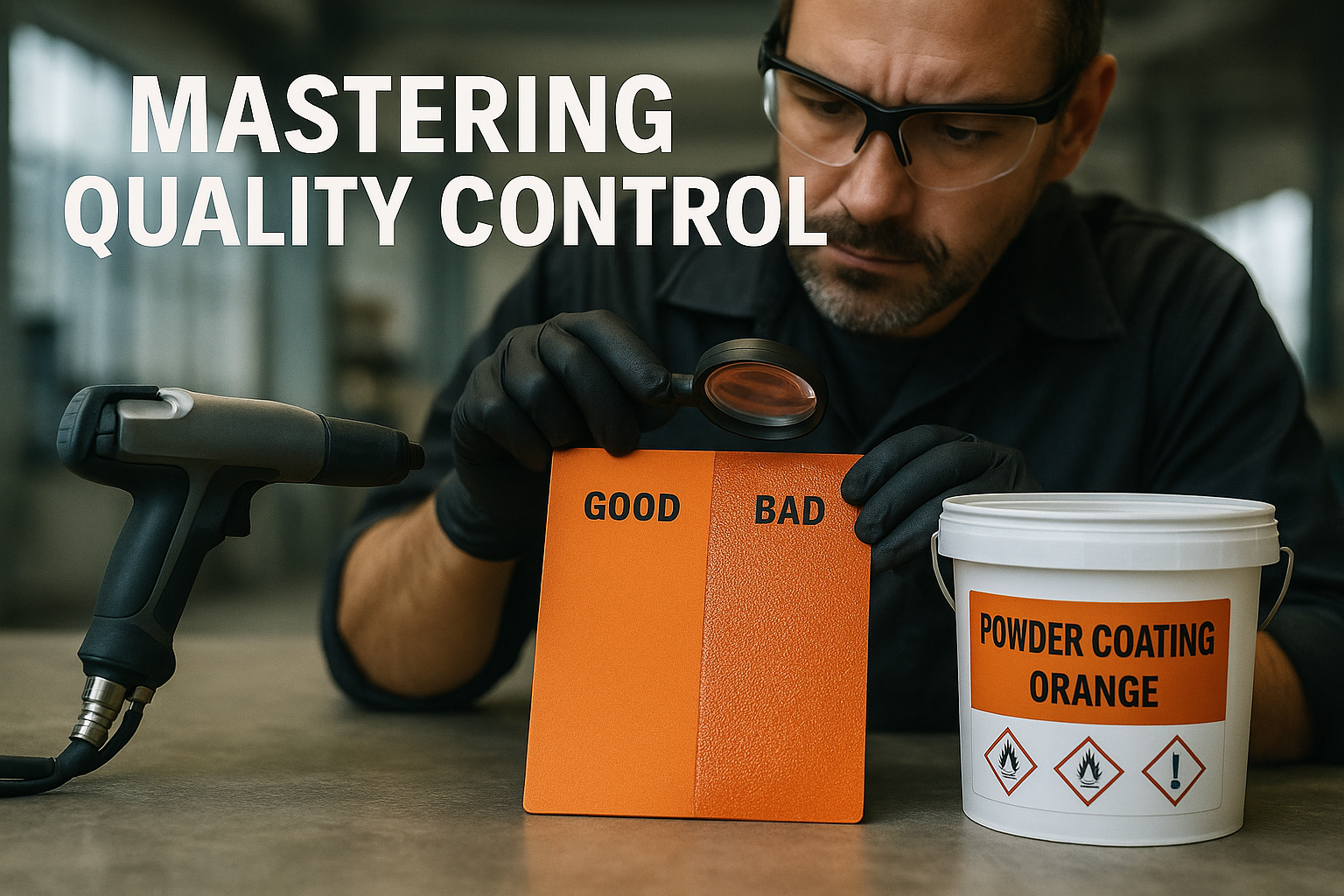
Author: Andrew Holmes in: Painting and Coating
Quality Management
Orange peel powder coating can slip past your usual quality checks and show up as a hidden snag in your finish. When this texture flaw appears, it is usually signaling deeper issues that disrupt your production flow and customer satisfaction. This playbook breaks down how to spot orange peel, trace its root causes, and track corrective actions clearly through non-conformance reports. Read on to learn how to shut down powder coating defects before they cost you more.
If you’ve ever run your hand across a finished part and felt a texture like the skin of an orange, you’ve encountered orange peel, one of the most common finish defects in powder coating.
It doesn’t usually mean the part is weak or unprotected, but it does signal process variation. And in the world of quality and compliance, that means it’s time to find and fix the root cause.
Orange peel is easy to spot once you know what to look for:
Visual: A dimpled or uneven surface under normal light
Tactile: Feels slightly rough or bumpy to the touch
Performance impact: Usually cosmetic, but can indicate over-curing or poor film integrity if severe
To ensure your team is identifying orange peel early and often, build a simple visual standard chart in your QA station showing acceptable vs. unacceptable textures. This helps operators make faster, consistent calls before parts reach final inspection.
The presence of orange peel can impact the perceived quality of your products. Customers expect a flawless finish, and any texture irregularity leads to dissatisfaction and potential returns. This defect also means more serious underlying problems in your manufacturing process. If not addressed, it will usually result in eventual rework and increased scrap. Addressing orange peel early saves money and preserves your brand’s reputation. Consistent quality checks and immediate corrective actions are keys to proactive, preventive intervention.
Understanding why orange peel happens is crucial. It’s not just about fixing the surface issue; you need to dig deeper to find the root cause.
There are many factors that could be contributing to orange peel in powder coating.
|
Process Area |
Common Root Cause |
Typical Signal |
|---|---|---|
|
Application |
Incorrect gun settings, distance, or powder flow |
Texture appears inconsistent across part surfaces |
|
Material |
Oversized or uneven powder particles |
Repeats even after equipment adjustment |
|
Environment |
Humidity, contamination, or poor grounding |
Surface shows both smooth and rough zones |
|
Curing |
Oven too hot or unevenly heated |
Texture worsens with heavier film builds |
|
Pretreatment |
Residue, oil, or incomplete dry-off |
Orange peel appears patchy or localized |
Every cause tells a story and each story should tie back to your non-conformance reporting (NCR) system.
Once you’ve identified possible causes, the next step is tracing these back to their origin. Start by examining your equipment. Ensure all components are functioning properly and are regularly maintained. Monitor environmental conditions in your workspace, as fluctuations can significantly impact coating performance. Reviewing process logs and production data can reveal patterns or anomalies leading to defects. Engage your team in discussions to uncover insights and potential oversights. By systematically investigating each aspect, you create a comprehensive view of the issue, paving the way for effective solutions.
Spotting and understanding orange peel isn’t enough. You need to take actionable steps to correct it. Use your NCRs not just to document defects, but to build a root-cause playbook over time.
|
Root Cause |
Corrective Action |
Long-Term Fix |
|---|---|---|
|
Poor spray technique |
Retrain operators, adjust gun angle/distance |
Standardize setup sheets for each part |
|
Powder quality issue |
Verify batch and supplier |
Implement lot tracking and vendor audits |
|
Oven hot spots |
Map oven temperature with data loggers |
Add regular calibration and maintenance schedule |
|
Pretreatment residue |
Review chemical concentration and rinse stage |
Tighten washer test frequency and documentation |
This approach turns one-off quality issues into data-backed improvements that feed your continuous improvement cycle.
Non-conformance reports (NCRs) are invaluable tools for tracking defects and implementing improvements. They provide a structured way to document deviations, their causes, and corrective actions taken. When tracked consistently and treated with the importance they deserve, NCR data can help you:
Spot recurring issues by shift, part type, or color
Correlate defects to specific lots or suppliers
Justify investments in new guns, ovens, or process controls
Demonstrate compliance readiness for audits and customer reviews
By transforming NCRs into learning tools, your team moves from reactive firefighting to proactive, predictable quality management. This data-driven approach supports continuous improvement, helping you to prevent future defects and maintain high-quality standards.
Orange peel powder coating may start as a cosmetic defect, but it’s a valuable signal of process health. Treat it as data, not damage. With consistent detection, root-cause documentation, and corrective action tracking, your finishing line will deliver smoother parts, stronger compliance, and fewer reworks.
Turn every NCR into a data point for better process control and remove “orange peel” from the fruit of your labor as early in the process as possible.

For more information about how OnRamp ERP software can add value to your business fill in the contact form below. A member of our support team will contact you within 1 business day to discuss any questions you have.
Start the collaboration with us while figuring out the best solution based on your needs.
Has your business outgrown a patchwork of disconnected systems? This checklist helps you assess readiness, identify gaps, and prepare for a smooth transition.